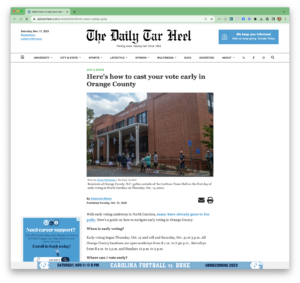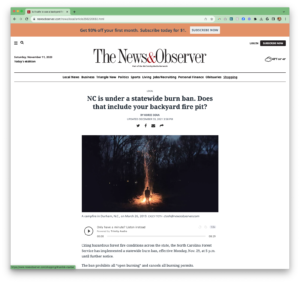Frequently Asked Questions alternative story format popular with reporters, readers
By Andy Bechtel
Readers of student media often have questions about things in the news. College journalists can provide answers using the “frequently asked questions” format.
Korie Dean, a reporter at The News & Observer in Raleigh, North Carolina, specializes in FAQ stories. She’s reported and written them about topics such as COVID restrictions, health insurance and bans on outdoor burning.
“You might find yourself asking questions about a new law that’s gone into effect, a confusing term that’s related to the news of the day, a viral post on social media or just about anything else,” says Dean, a 2021 graduate of the journalism school at UNC-Chapel Hill. “Those topics make for fantastic FAQs, because they’re things people undoubtedly have questions about and will be searching (literally searching on Google — SEO is key!) for answers on.”
So when should you try a FAQ, and how do you put one together? Here’s what you need to know.
QUESTION: What is an FAQ post?
Answer: A news story, press release or web page that’s structured in a question/answer format. Just like this post.

Q: Why use the FAQ format?
People often have common questions about an event, organization, issue or trend. The FAQ format is easy for readers to search and to skim for information that they are looking for.
“The common tie is that people will want the information in an easy-to-understand, digestible format that quickly equips them with the information they need,” says Dean, who wrote for student publications Media Hub and The Durham Voice while a student at UNC.
Q: When should we use the FAQ format?
The FAQ format is handy for “teachable moments” — like a “how to” guide about a topic. It’s also useful for information about an announcement, policy change, etc.
Q: How do we brainstorm an FAQ story?
Use the “how what why when where” of news judgment to anticipate reader questions. You can also solicit questions from your readers using social media. That brainstorming and information gathering will be the framework for your FAQ.
“You want your story to be a one-stop shop for answers about the given topic, making sure to address as many questions as possible, anticipating what questions readers will have to begin with, as well as additional questions they might have after learning the basic facts that you present,” Dean says.

Q: How do we start an FAQ story?
Write a brief lead of one or two paragraphs to introduce your topic. Consider using the direct address, speaking to the reader like a friend or guide. Then go directly into the questions and answers.
Q: How do you organize an FAQ story?
Order the questions in a way that makes sense. Start with the fundamentals — often a “what is” question works well. Each answer should lead naturally to the next question, like a conversation or interview.
“One of the first stories I did in my current job was an explainer on the Emerald Ash Borer, an invasive pest that’s killing ash trees across North Carolina. I could have easily started that story by jumping straight into questions about the bug and the harm it causes — but as I started writing, I realized that I, personally, didn’t even really know what an ash tree was or what one looked like,” Dean says. “I figured there was a good chance many readers would have the same experience.”
Q: How long should each question/answer be?
Each question should be one sentence of no more than 30 words. Lengths of answers may vary, but aim to be concise. Don’t forget to check for Associated Press style, grammar, etc.

Q: How long should an FAQ story be?
It depends. The more concise, the better. But sometimes people have a lot of questions! If your FAQ is getting long, consider dividing it into categories with subheads.
Q: How should the FAQ end?
One option is to use a “call to action.” How can readers learn more or participate? Another option is to end with a “what’s ahead” or “what’s next” question, which foreshadows more news on the topic.
“I try to always list resources at the end of the story where readers can go for more information, if needed,” Dean says. “That could be contact information for someone at a government agency or just additional online resources.”

Andy Bechtel teaches writing and editing at the Hussman School of Journalism and Media at UNC-Chapel Hill. He joined the faculty in 2005 after about a dozen years in newspaper journalism. Bechtel is the author of two online courses for Poynter Institute’s News University: one on the fundamentals of editing and another on alternative story forms. He has also written reviews and articles for publications such as Journalism & Mass Communication Educator and Tracking Changes, the newsletter of ACES: The Society for Editing.

